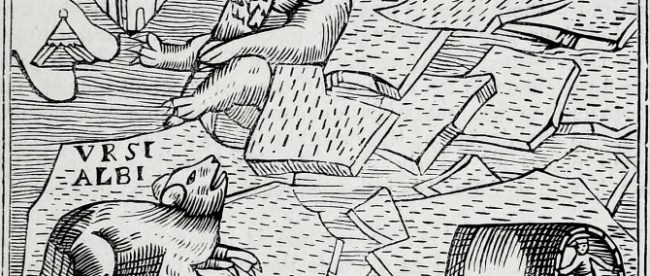The Weekender, June 9, 2017

1) “The Thoughts of a Spiderweb” (Quanta Magazine, 11 minutes, May 2017). This is absolutely fascinating.
Millions of years ago, a few spiders abandoned the kind of round webs that the word “spiderweb” calls to mind and started to focus on a new strategy. Before, they would wait for prey to become ensnared in their webs and then walk out to retrieve it. Then they began building horizontal nets to use as a fishing platform. Now their modern descendants, the cobweb spiders, dangle sticky threads below, wait until insects walk by and get snagged, and reel their unlucky victims in.In 2008, the researcher Hilton Japyassú prompted 12 species of orb spiders collected from all over Brazil to go through this transition again. He waited until the spiders wove an ordinary web. Then he snipped its threads so that the silk drooped to where crickets wandered below. When a cricket got hooked, not all the orb spiders could fully pull it up, as a cobweb spider does. But some could, and all at least began to reel it in with their two front legs.
Their ability to recapitulate the ancient spiders’ innovation got Japyassú, a biologist at the Federal University of Bahia in Brazil, thinking. When the spider was confronted with a problem to solve that it might not have seen before, how did it figure out what to do? “Where is this information?” he said. “Where is it? Is it in her head, or does this information emerge during the interaction with the altered web?”
In February, Japyassú and Kevin Laland, an evolutionary biologist at the University of Saint Andrews, proposed a bold answer to the question. They argued in a review paper, published in the journal Animal Cognition, that a spider’s web is at least an adjustable part of its sensory apparatus, and at most an extension of the spider’s cognitive system.
2) Sponsored:: Get Matched With The Perfect Wine!! Winc is upgrading the way you discover & buy wine. They are eliminating the guesswork by matching you with personalized wine recommendations. Answer six simple questions about what you like to eat and drink and Winc will match you up with wine you are guaranteed to love. Take the quiz and get $20 off your first order of wine!
(Really, this is a pretty great offer. They sent me four bottles for free, which I shared with some friends — my friends, who drink more wine than I do, all were pretty impressed. Assuming I did the math right: If you buy the minimum three bottles, you can get three for about $32 with the discount but have to pay for shipping. If you buy four, shipping is free and it comes out to about $36.)
3) The Now I Know Week in Review:
- Monday: The Green Versus the Eardrums — SunChips tried to make their product better for the environment, but instead, they made it really loud.
- Tuesday: Why Americans Were Almost Hungry Hungry for Hippos — Invasive plants, lake bacon, and other things that don’t sound like a good combination.
- Wednesday: The Eyes Have It — how you can see your own white blood cells.
- Thursday: Why Mattresses Come With Warning Tags — Why mattresses come with warning tags.
And a bonus item: Accidentally Awesome — the brief, lucky history behind the chocolate chip cookie.
4) “How Polar Bears Became the Dragons of the North” (Smithsonian, 9 minutes, May 2017). Dragons are mythical creatures that prey on people. Their legendary cruelness spread in stories, of course, but also in maps — mapmakers would often adorn areas in which man was unfamiliar with dragons (or their cousin, sea monsters). But again, they turned out to be fake. In some areas, though, the polar bear — a real creature — was the menace of the maps. Here’s how polar bears took on a dragon-like mythical status in some areas of northern Europe during the Renaissance period.
WeekenderAdUnits
5) “I Lost My Voice, but Help Others Find Theirs ” (New York Times, 8 minutes, June 2017).
I was born in Nashville in the summer of 1990. A year later, it became clear to my parents that I could not see well, and by the time I was 2 years old, tests revealed that I was completely blind. As far as my family was concerned, this was of no matter. I was raised to think with no limits. For many years I attended public schools with sighted students, getting in trouble for the usual things like running in the halls. On my own decision, I began attending the state school for the blind when I was 11, where I played sports and graduated as the school’s valedictorian.
When I was a senior in high school, a doctor noticed during a routine exam that my voice sounded abnormal to him. Further testing disclosed nine noncancerous tumors located on cranial nerves, which control almost everything about how the body’s extremities work.
The diagnosis was neurofibromatosis Type 2, a disease caused by an inherited or spontaneous genetic mutation. About 100,000 Americans have one of the three forms of NF — NF Type 1, NF Type 2 or schwannomatosis, according to the National Institute of Neurological Disorders and Stroke. There is no cure, and extensive monitoring and treatment of individual symptoms is currently the recommended treatment.
6) “The Best Stuff to Do On the Google Homepage That Isn’t Googling” (Gizmodo, 5 minutes plus the time to try the stuff out, May 2017). I’ve written about some of these before but this list is longer and more current. Some other Google tricks: check out the search results for “do a barrel roll,” “askew,” “recursion,” and “once in a blue moon.”
Have a great weekend!

